In Silicon Valley, where the political divide lies less between left and right than within liberalism itself, attending a Donald Trump rally feels like stepping into an alternate reality. For Mike Siebenhaar, a 56-year-old conservative from Gilroy, it’s a coming-out, a chance to show his true ideological colors.
“I can’t put a Trump sign out on my lawn,” says the South County business owner, one of thousands of people who flocked to downtown San Jose last week for Trump’s campaign event. “I don’t feel safe doing it. Not where I’m from.”
Hours ahead of the New York billionaire’s scheduled appearance—before the egg-throwing, pepper-spraying, pushing, chasing, punching, traffic cone-throwing and hat-burning that dominated headlines the next day—Siebenhaar and hundreds of like-minded Trump supporters stand in the sweltering heat outside of the San Jose Convention Center’s blue-and-white South Hall on Market Street.
Police barricade a several-block buffer around the venue, allowing only people who registered online past the metal barriers. No anti-Trump signs allowed beyond that point.
A couple blocks away in Plaza de Cesar Chavez, protesters gather, hoisting banners that remind Trump’s followers that they’re an unwelcome presence in a city where some 40 percent of the population is foreign-born. “Mr. Hate, get the fuck out our state,” one banner reads. “Brown ‘n’ proud,” exclaims another.
The massive striped tent, a red-white-and-blue-decked crowd, peddlers hawking bottled water and a cowboy guitarist crooning praises to Trump give the scene a traveling circus feel. Adding to the vaudeville effect are the street vendors who’ve followed the Trump train from rally to flag-waving rally since the Iowa caucuses and set up shop along South First and San Carlos streets.
“We’re like a bunch of carnies,” says 51-year-old, sun-ruddy Florida native Ron Hillyard, who pulls a rolling cart of campaign T-shirts, the ubiquitous “Make America Great Again” hats and various pins blasting ISIS and boosting “hot chicks for Trump.”
“It’s business, you know, but I’m here for Trump, too,” Hillyard says. “He speaks to me and mine.”
Ben Meyer, a 20-year-old Latino college student, shows up well ahead of the rally in what he jokingly calls a disguise: a denim-on-denim ensemble cinched in the middle by a thick leather belt.
“I figured the whole Western look would make me blend in,” says the San Jose native, who watched Bernie Sanders stump in Palo Alto earlier that week. “Do I look the part?”
All but for a “Great Again” snapback, I tell him. Bonus points for rocking a campy button, like the one I saw at least twice in the first hour that read, “KFC Hillary Special: 2 fat thighs, 2 small breasts.”
“Well, there’s one thing they have in common with Bernie supporters,” Meyer says. “They hate Hillary [Clinton] with a passion.”
So it seems. Not much later, a Trumpeteer—Siebenhaar’s 30-year-old nephew, Justin Siebenhaar, incidentally—strikes a pose for my camera in a “Hillary for Prison 2016” T-shirt. Another shows off his a red “Hillary go to jail” number disparage Trump’s presumptive Democratic opponent.
Throughout the evening, supporters say they’ve narrowed their options to either Sanders or Trump—anyone but Clinton. Like the Bernie camp, Trump folk consider the former secretary of state corrupt, the guardian of a status quo that’s brought crushing inequality and stagnant wages to millions of Americans.
Silicon Valley as an industry and a left-leaning enclave may have united in opposition against Trump, whose inflammatory rhetoric about Mexicans, women, Muslims and undocumented immigrants—among others—has stoked racial tensions. But the billionaire businessman’s America-first message resonates with a surprisingly diverse set of Bay Area locals who feel cheated out of the region’s prosperity.
“Without immigrants, this country wouldn’t exist,” says Jaime Abad, a 48-year-old Trump supporter whose family moved to the United States from the Philippines when he was a kid. “When we got here, we started with nothing. My main thing now, what got me to support Trump, is that all these jobs are leaving the country. All the manufacturing is going to Mexico. What’s left for us?”
A couple dozen people I spoke to before, during and after the rally wonder the same. Some fit the type—white, male and middle-aged. But a there’s a sizable number of minorities and first-generation immigrants like Abad.
On the surface, it makes no sense. How can Latinos rally behind a man who unapologetically called Mexicans rapists? How can so many people born abroad join the chorus to “build that wall?”
Yet here they chant, armed with posters and pins declaring their fealty to an unabashed nativist. One such sign catches the eye for its glittery letters and absurd specificity: “Mexican Millennial Woman 4 Trump.” When results for the primary election came in days later, they showed that 36,000 Santa Clara County voters picked Trump as the Republican presidential nominee.
“When you come here legally and you put in the seven years it takes to become a citizen, it makes you angry to see people cut in line,” says Aurora, 63, who withheld her surname for fear of her coworkers finding out she’s a die-hard Trump fan. “I was 15 when my family left communist Cuba, with $400 in our pockets. We worked our way up and never took a dime from anyone. But somehow we’re asked to give more and more and retain less and less of our efforts.”
Aurora and several others who spoke to San Jose Inside decried not undocumented immigrants so much as the tech industry’s reliance on legal H-1B visas, which allow employers to import high-skilled workers from abroad and pay them low wages. Trump’s campaign platform calls for sweeping reform of the skilled-worker visa program.
“My 26-year-old daughter did everything right,” Aurora says. “She went to college, she got a master’s degree. Yet she’s buried in student debt and she can’t compete with these foreign workers, even the legal ones, who will take the same job requiring a college degree for $15 or $12 an hour.”
Danielle Marquez, a 20-year-old Vallejo resident of Mexican descent, says she appreciates that Trump has been so outspoken about business as usual in Washington.
“I wasn’t into politics before, but then he showed me the revolution that’s going on,” she says, sitting cross-legged on the floor an hour ahead of the keynote address. “It’s amazing to see someone speaking out against everything that’s corrupt in the world.”
And what of Trump’s spoken hostility against Latinos?
“Well, my family came here legally,” she tells me. “They all pay taxes. I have no problem with people coming here, as long as they come here legally and by the books.”
An African-American woman from Berkeley, a lesbian from San Leandro and another young Latina from Vallejo tell me the same, that Trump’s rhetoric against minorities—especially Mexicans—doesn’t faze them either.
“He’s an asshole,” Sherri, a gay ex-Democrat who also declined to share her last name, tells me when asked about Trump’s sexist comments about women. “Have you ever said shit about men? I have said shit about every type of person there is when I’m mad. But doesn’t that kind of make [Trump] more human?”
Kraig Moss, a 57-year-old New York state guitarist who has followed Trump to a few-dozen rallies shilling a CD of original pro-Trump songs, acknowledges that his preferred candidate has crossed the line.
“He’s done a few things that make me cringe,” he says. “The mocking the handicapped reporter was in such bad taste. But I also know he’s been under a lot of stress, a tremendous amount of fatigue, and you can see that it was wearing on him.”
By the time the Republican presidential nominee steps onto the stage, Siebenhaar has endured hours of waiting—first in the sun and then in a sweat-soaked crush of bodies camped out by the stage inside the convention center’s blue-and-white tent. He lets out a celebratory yawp with the crowd, holding up his “Trump 2016” sign to welcome the only candidate in his entire life that excited him enough to register as a voter.
“Where are the Hispanics?” Trump bellows. “We love the Hispanics!”
About 20 minutes into his rant against Clinton, his presumptive Democratic opponent, a group of Latino protesters work their way toward the stage. Siebenhaar and a host of others point and shout in their direction.
“Get out,” Siebenhaar yells, nearly knocking me in the face by jerking his arm up to point at the suspected dissenters. “You don’t belong here.”
Unlike at past rallies, where Trump has openly called for violence against protesters, the candidate seems derisively amused by the event crashers.
“All right, don’t hurt him,” he says, joking about how the protesters should stay and enjoy themselves. “See the way I said that? I’ve learned. Don’t hurt him, please.”
“Darling,” Trump says to a woman holding a Sanders poster, “there’s no way he can win, but you keep your sign high.”
No violence erupts inside the event, but the rustle within the crowd continues throughout the next hour, punctuated here and there by the repeated chant to “build that wall” or “go back to Mexico.”
Siebenhaar calls one of the female protesters, a young Latina in a “Brasil” crop top, a “beyotch” and repeatedly tells her to “fuck off” and “go home.”
“This is our rally,” he turns to tell me after the young woman disappears into the crowd. “They should know better.”
- “Latinas for Trump” show off a homemade sign. (Photo by Jennifer Wadsworth)
- Kraig Moss entertains people who showed up hours early to stake out a place in line. (Photo by Jennifer Wadsworth)
- Strong Sims (in red), 11, says she convinced her whole family to hop on “the Trump train.” As San Francisco residents, they say, it hasn’t been easy showing support for the right-wing candidate in a liberal city. (Photo by Jennifer Wadsworth)
- Justin Siebenhaar and his uncle Mike Siebenhaar said they support Trump’s “America first” policy. (Photo by Jennifer Wadsworth)
- Kraig Moss shows off the countrywestern album of pro-Trump, “Make America Great Again” songs. He sold 10 copies before the event started. (Photo by Jennifer Wadsworth)
- One of the many pro-Trump buttons sold by traveling vendors outside the event. (Photo by Jennifer Wadsworth)
- Donald Trump began railing against his Democratic opponent, Hillary Clinton, right out of the gate. (Photo by Jennifer Wadsworth)
- Kraig Moss sings some of his original Trump-themed anthems for people waiting in line. (Photo by Jennifer Wadsworth)
- A sign placed outside the event venue. (Photo by Jennifer Wadsworth)
- Cowboy crooners for Trump. (Photo by Jennifer Wadsworth)
- Jaime Abad, of Union City, and John Wood, of Palo Alto, say they support Trump’s stricter immigration proposals. (Photo by Jennifer Wadsworth)
- Trump-themed souvenirs hawked outside the event. (Photo by Jennifer Wadsworth)
- Trumpeteers in all their red-white-and-blue splendor. (Photo by Jennifer Wadsworth)
- Ben Meyers, 20, says he’s an undercover lefty who wanted to experience the Trump phenomenon for himself. (Photo by Jennifer Wadsworth)
- At 16 years old, John Houghton’s too young to vote, but he’s showing his support in other ways. (Photo by Jennifer Wadsworth)
- Robert Garcia (left), 45, called Trump’s speech “very inspirational.” “He’s not backing down,” Garcia said. “It shows that we’re on the right track.” (Photo by Jennifer Wadsworth)
- Diana Carreras, a 58-year-old Apache native, peacefully protests as Trump supporters leave the convention center. “I don’t want racism, I don’t want hate,” she said. ” I want peace.” (Photo by Jennifer Wadsworth)
- Trump supporters point and shout in the direction of a protester. (Photo by Jennifer Wadsworth)

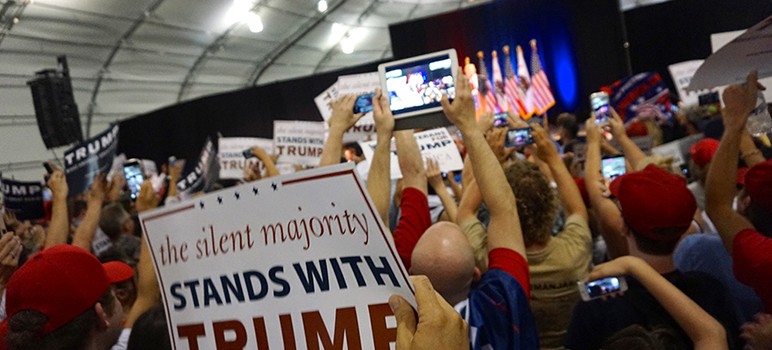






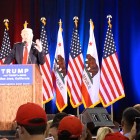

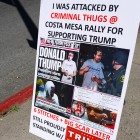




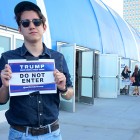

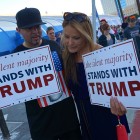


> On the surface, it makes no sense. How can Latinos rally behind a man who unapologetically called Mexicans rapists?
Utterly deceitful. In fact, this seems to be progressives most useful and most favored distortion.
It is really exploiting a vaguery of the English language. When a speaker refers to “Mexicans”, he or she may be referring to: A.) ALL Mexicans or, B.) to some individuals who are Mexicans.
When Trump referred to Mexican rapists, reasonable, rational people, inclined to give a fellow human being — Donald Trump — the benefit of the doubt, presumed he was speaking in the sense of “syntax B”: “some people who are Mexican” are rapists. Absolutely true.
Progressive activists and demagogues, deeply marinated in anti-Trump prejudice, always seek to impose “syntax A” on Trump’s statement, thereby validating their prejudice. “”Trump called ALL Mexicans rapists. Trump hates Mexicans”. If an ethical, honest journalist recognized that there was an ambiguity in Trumps comments on “Mexican rapists”, an ethical, honest journalist might ask: “Which sense did Trump mean”.
“Mr. Trump: Did you mean ALL Mexicans or SOME Mexicans”. Instead we get deceitful, distorted “narrative” founded on ambiguity and invidious inference.
Latinos support Trump because what he actually said is that Mexico is sending some of its worse people over here illegally, including rapists. Which is factual. He never said all Mexicans were rapists. Stop twisting his words.
I see. So Trump was mentioning the obvious truism that “some Mexicans are rapists.” A truism as obvious and trivial as – “some Caucasians are rapists.” Yet somehow, Trump mentioned Truism #1 without mentioning Truism #2. Why? Because he is talking about immigration policy? But wait, don’t we get Caucasian immigrants now and then? And if it’s such a trivial and obvious truism that “some” Mexicans are rapists, why mention it at all? You’re suggesting it’s about as significant as “sometimes my butt itches,” and presumably, just as irrelevant to a presidential election.
And by the way, how relevant is it to immigration policy that a judge born in Indiana happens to have Mexican ancestors?
You’re making no sense.
> But wait, don’t we get Caucasian immigrants now and then?
Thank you for asking, and the answer is “NO,we don’t.”
Immigration policy is strongly skewed against “European” immigration.
Ask Ted Kennedy.
You must not have met too many kids’ soccer coaches in the bay area. They are primarily first-generation European immigrants (and incidentally, often “good people”). Maybe you’re living in your own bubble.
You must not have met too many kids’ soccer coaches in the bay area. They are primarily first-generation European immigrants (and incidentally, often “good people”). Maybe you’re living in your own bubble.
> A truism as obvious and trivial as – “some Caucasians are rapists.” Yet somehow, Trump mentioned Truism #1 without mentioning Truism #2. Why?
No need to diss “Caucasians”. They’ve already been dissed in every imaginable way be the progressive elites.
There is nothing ugly that anyone can say about “Caucasians” that has not already been said by the multiculturalists and diversity engineers.
I get it. So your candidate was trying to balance the racial equation by dissing Mexicans selectively. Because as you say, there’s “no need” to diss Caucasians, but obviously a real “need” to diss Mexicans. Makes perfect sense. Not racist at all.
SJO – I didn’t know were a professional Hillary troll, cause whole line of argument is a winner.
Excuse me?
https://travel.state.gov/content/visas/en/general/a-z.html
Just for one example, I frequently hear people speaking Russian in Silicon Valley, where one never heard that language spoken so freely in public, in the nineties and earlier.
This Valley has a Venal and Sordid History regarding those who are not white, and are able to walk over the border, and you’re too effing old and clever not to understand that, sjoutsidethebubble.
If Trump weren’t such a females as raw meat arm candy creep, and had wanted to solely talked about SORDID LEGALIZED IMMIGRATION ISSUES, certainly including those more obscure Visa’s for wealthy despotic minded f-cks (or their despotic minded f-cks parents) like Professors John Choon Yoo (and his love of torture) and DemRat, Harold Hongju Koh ( http://www.counterpunch.org/2010/05/14/how-liberal-law-professors-kill/ ), I might have even voted for him come November; as it is I’ll likely be, once again, writing in a name.
DIANE:
You lost me.
Yeah, Diane, you lost me too. Your posts are becoming as disjointed as Frank Mockery’s, but without nearly so much ad hominem invective. And what’s with the stuff on a shaded blue/grey bckground? Are they your comments with emphasis, or a response from Jenn without attribution?
MEXICANO2 – May I humbly suggest a different read of this article. I think the conversation with Aurora and others point out two fundamental issues with the status quo. One, with a greater supply of workers, at all levels, lower the cost of labor. I think we have seen this across CA and the rest of the country over the past few decades. Also, in the past when a company was tied to its community, the owners were forced to find common ground with the employees. Under Globalism, the private union has lost much or all if its bargaining power, and even if the factory stays, the realistic threat of moving it off shore hangs over employees diminishing their negotiating power. This does not just happen in factory towns, but at tech companies in the Bay Area.
It is interesting that this article does not point out one more consequence of an open boarder / globalist policy. The impact on housing costs. In some of the “forgotten” areas in the US, housing is cheap mostly because there is no work. However, the Bay Area, ordained a “winner” in the globalism sweepstakes, has plenty of jobs. Unfortunately it is such a winner that the community can not absorb its own success. While landlords take the blame, a major cause of massive increase in housing costs has been exactly what Trump is arguing against, the influx of low skilled workers from Central America and H1B employees from all over the world. The sheer number of people and money entering the housing market has reset the price points pretty much out of reach for everyone. Rent Control and government price interference will not solve it, only a significant reduction in demand or large growth in supply will bring housing in line.
The displacement and high rents here in the Bay Area and the stagnation in the midwest and rust belt are two sides of the same coin. It is a shame that the conversation has come to the point it is now. There is talk that the Laws of Supply and Demand are broken, I disagree, and further rejection of them will have damaging unintended consequences. The outcomes we are seeing are predictable when a system is overwhelmed by changes without sufficient time to adjust.
This is a debate worth having, because there are benefits to Globalization. It is not clear if the benefits outweigh the costs, particularly to the middle class in the US.
SJ Citizen, thank you for the rational dialogue. To be honest, my comments were not directed at the article. They were directed at SJO’s word games with the meaning of racism. Even sensible Republicans are asking Trump to retract his comments now. To me, using word games to justify Trump’s comments (“some Mexicans” vs. “all Mexicans”), implying that no diss was meant against Mexicans, but then acknowledging that the same comment against Caucasians in fact would be a diss — all of this, to me, is senseless, coded gobbledygook.
I do appreciate your engagement on the substance of the discussion and your good points.
MEXICANO2 – Thanks. Actually I am not sure sure Trump is the real Republican in this race. I would place Bill Clinton as the most effective GOP president since Eisenhower, and I am not sure how much of that was Bill and how much was Hillary. I am not quite sure what Trump is, but he does not fit my definition of Republican. Actually I think he will forever destroy the Party by ending unhappy marriage between the intellectual Republicans and the rank and file. The idea of turning the Republican Party into a Warrior/Worker party where the idea is to enrich US citizens, perhaps not at the cost of the outside world, but certainly not with the aim of sacrificing them at the alter of an unproven borderless theory of governance.
This won’t come for free. A number of things may happen. Certainly, there will be inflation. iPhones and flatscreens won’t be cheap and there will be some serious trade disputes. However, you would be surprised how little of the economy is actually tied to foreign trade, about 14%. Even moving production back to the US will likely not be enough. Job growth will have to come from infrastructure and that will be very expensive. Domestically energy development will provide economic security and jobs. And of course, H1B visas and low skill labor immigration will need to be better controlled to reduce competition for jobs and housing and mitigate dilution of the social program reserves. It would be likely that foreign bases would be closed, or allies would be asked to pay for their services, but Security Policy would retract to a more defensive posture vs global adventure.
There are many powerful forces in the way, of course, and the deeper moral question of looking out for Americans first, the rest of the world second. If you listen in between the emotional flare ups, you will see a lot of that in the positioning with Trump. I am not so sure it fits into either party and I am not so sure it is still possible. I do not think Clinton has the desire or flexibility to do this as head of the Democratic Party, given the support it receives from the powerful forces against these concepts.
I would ask these ideas are debated when judging Trump. I think this election is much more than the current noise that is filling the airwaves.
I do agree that party affiliation does not correlate with ideology. Bill Clinton and Arnold are basically the same guy politically. Trump is very undefined to me right now. Other than – he loves being a shock jock. But yes – media sensation and political reality are two different things.
Per Dept of Homeland Security website, and the latest Yearbook on Immigration Statistics (2014), admission priorities to becoming a “lawful permanent resident” are not skewed against European immigration.
If you mean the Hart-Celler Act of 1965 (perhaps the source of your oblique Ted Kennedy reference?) eliminated the immigration preferences given to European immigration (and northern and western Europeans over southern and eastern ones, at that) and placed all countries on the same ratio, then I guess immigration policy became “skewed” against Europeans in that they were no longer given preferential treatment and other regions (namely Asia and Africa) drastically limited with quotas.
Per Dept of Homeland Security website, and the latest Yearbook on Immigration Statistics (2014), admission priorities to becoming a “lawful permanent resident” are not skewed against European immigration.
If you mean the Hart-Celler Act of 1965 (perhaps the source of your oblique Ted Kennedy reference?) eliminated the immigration preferences given to European immigration (and northern and western Europeans over southern and eastern ones, at that) and placed all countries on the same ratio, then I guess immigration policy became “skewed” against Europeans in that they were no longer given preferential treatment and other regions (namely Asia and Africa) drastically limited with quotas.
In current immigration policy, there are preferences based on family relationship, employment, and diversity. There are other categories, but none are skewed for or against any particular country or geographic region (outside of the small preference (~5% in 2014) given to countries in the “diversity” category mentioned earlier). Each country has a limit to how many visas can be issued to its residents, but this percentage is the same across all countries, European or not.
In real numbers, it is true that very few immigrants come from European countries (nowadays). As of 2014, the leading country for legal immigration is Mexico (13.2%), followed by India (7.7), China (7.5), and the Phillipines (4.9). The leading region is Asia (42.4%), with second-place North America (31.9) being split between Carribbean (13.2%) and non-Central-America (that is, Mexico and presumably Canada) (14.4%). These percentages were largely similar in 2013 and 2012. Source: https://www.dhs.gov/sites/default/files/publications/LPR%20Flow%20Report%202014_508.pdf
However, if you look at the overall ancestry of the US, the largest country of origin is Germany (as of the 2000 census), followed by English, Italians, French, Welsh, Scottish and Irish. See:
https://en.wikipedia.org/wiki/File:Census-2000-Data-Top-US-Ancestries-by-County.svg
> the largest country of origin is Germany
Really?!!!
When is German-American history month?
When is German-American heritage night at the Giants game?
Really!x4 It’s called Oktoberfest, and the SF Giants celebrate it on Sep 26 this year. However, it’s already sold out. Guess it is kind of popular.
http://sanfrancisco.giants.mlb.com/sf/ticketing/group_special_events.jsp?group=oktoberfest
Curiously, they never seem to mention anything about the ethnic group that originated “Oktoberfest”.
It might make too many white people feel too good about themselves.
More likely it’s what happens when you are the dominant tribe. You have less to explain about your celebrations, traditions, mores, and the like.
I don’t get the same sense of petulant defiance when I go to these kinds of celebrations that you seem to imply, but perhaps I’m mistaken. It might indeed be a vast conspiracy to keep the European stock among the populace from feeling good about themselves.
Trump is better that a lying woman and a cheating husband. He is the best of two evils. Go Donald but regardless, we are all is a world of hurt. Sad this is the best the country has to offer.
Josh, I love how you sensor me but let ongoing posts between a few continue. You need to set up a side blog so we don’t have to skip thru all this you said I said crap.
hello testing 1-2 why is my last post not on here/
> More likely it’s what happens when you are the dominant tribe.
German-Americans are hardly the “dominant tribe” in America.
The “dominant tribe” doesn’t seem to have much of a problem with Irish, French, or Italian Americans, but when German-Americans start showing any hints of self-esteem or cultural validation, the “dominant tribe” begins wondering aloud how white their relatives are and how much they seem to love them, and whether or not they are really “diverse”.